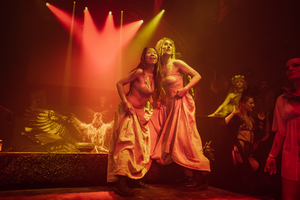Edinburgh 2022: Flabbergast Theatre Guest Blog
Flabbergast Theatre bring enchanting, imaginative version of a Shakespeare classic to the Fringe

Guest Blog: Flabbergast Theatre bring enchanting, imaginative version of a Shakespeare classic to the Fringe
Simon Gleave discusses interesting performance techniques such as mask play, Japanese dance, clown and choral singing and how one choreographer helped shaped the madness of Macbeth.
Cast member and Flabbergast Associate Artist Simon Gleave blogs for BroadwayWorld about bringing The Tragedy of Macbeth to the Fringe, how the creators and performers have integrated many different styles in the production and how this adds to the audiences' understanding and experience of the story.
Nothing is but what is not. (i.iii)
Making our faces vizards to our hearts. (i.iv)
Macbeth is a play about performance, about masking and deceiving; it is about fate, the future and the supernatural; about sex, power and violence. It is also about prolepsis - the anticipation of the yet to come - and prophecy - the envisioning of the yet to come. As such it is an act of imagination. It exists in the imaginations of Macbeth, Lady Macbeth, the Witches. It exists in Flabbergast's imagination. We hope most of all for it to live in the imagination of the audience.
Henry Maynard (Artistic Director of Flabbergast) started making Macbeth over 4 years ago. Weirdly, he started it from the perspective of clown. He started with the character The Porter and a desire that the original knock-knock joke (which comes from Macbeth) actually be funny. It's often played very seriously, taking the text as gospel when what we have written down is likely the recording of one actor's ad-libs and play to make the audience laugh, those jokes were written down and that's the text we have to work with, but it was only funny for that actor with that audience. That led to a lot of the early work through explorations of ridiculousness. When he married it with drums, polyrhythmic stomping and covering the performers in clay, the first marks of what has become Flabbergast's Macbeth were made.
Styles have been thrown at this project from the beginning: puppetry, clown, full mask, neutral mask, bouffon, chorus, choral singing, Butoh and the physical work of Matej Matejka.
In 2018 we started with masks and mask play to explore the body's role in miming the invisible, creating environments and spatial rhythm. We wanted from the beginning for the expressivity of our bodies to match the wild nightmarish poetry of the language and the masks gave us a route to embody the "nothing [that] is" and the "what [that] is not."
At the same time, research into bouffon was introduced. Bouffon, which accentuates and plays with the grotesque, helped us to mock the play and ourselves in it, using the work to express all of our profanity, madness, lust for power and base instincts, without pretending to comment on the actual contemporary world in order to justify ourselves.
Macbeth is also about the natural or supernatural power of women and the masculine violence that destroys women. The Witches are not (just) three hags on a hill singing nursery rhymes: they are women of nature, goddesses and the latest expression of witchery dating back to the Greek Goddess Hecate of Magic and Spells. They are also visible reminders of the persecution of thousands of women who were unjustly murdered by men for being witches throughout history.
In order to go deeper into witchery, a key encounter for the project was our work in Butoh with Marie-Gabrielle Rotie. Butoh is a Japanese dance and performance form that focuses on transformation, ugliness, weakness, it stretches times, embodies suspensions and cultivates spacious nothing as a means towards invoking a mysterious elsewhere, often touching death.
It seemed appropriate for Macbeth, particularly the witches. Lots of the gnarled transformations, fingers like tree twigs, fits, shaking, and the stretched stillness's between frantic actions emerge from our Butoh research.
Finally, the piece would not be what it is without the major work, teaching, dramaturgy and choreography of Matej Matejka. Matej has shaped our madness into form and much of the physical expression of the piece comes from his craft. He has pushed us with his technique, his discipline, his imagination. This has meant we have been able to express the sacredly rigid, patriarchal, military society of Macbeth against the demonically pagan, dangerously fluid nature of the play, all physically.
The cherry on the cake has been Adam Clifford's extraordinary music and sound arrangements, his use of bells, drums and voice to cultivate an exquisitely textured and captivating environment.
All this we hope communicates a Macbeth of raw materials and illusions: a sublime, funny and violent nightmare delivered with craft and mad, trance-like energy.
The Tragedy of Macbeth, Assembly Roxy (Central), 12pm, 4-29 August (not 17)
Sponsored content
Photo credit: Vessi Ven
Comments
Videos

